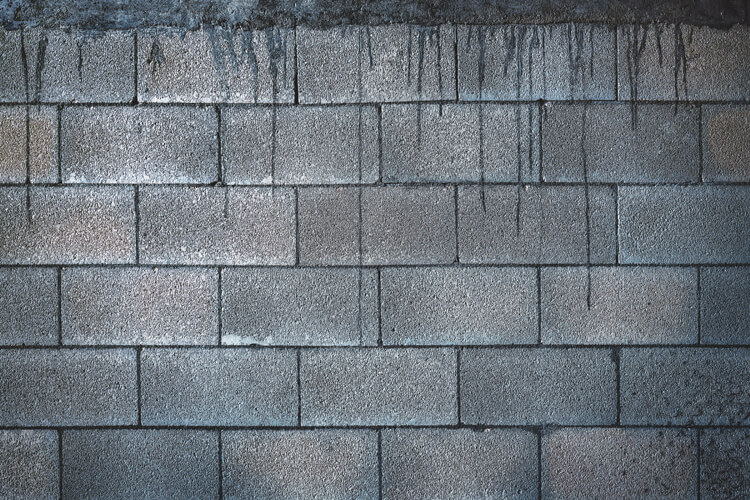According to the 2021 Old Farmer’s Almanac, this winter is going to be warmer and wetter than usual. Perhaps that’s what brought you here today. Is your basement collecting more moisture this winter? Have you noticed a musty smell or discoloration on your basement walls? If so, then the most-likely culprit is mold. It’s time to figure out how to get rid of mold on concrete block walls—and fast!
Why Concrete Blocks are Susceptible to Mold
Concrete blocks are made up of water, aggregate (gravel, rock, or sand), and Portland cement. The aggregate acts as a filler while the Portland cement acts as a binding agent. Many of the ingredients in Portland cement (what is commonly used in poured concrete today) are anti-fungal, such as lime.
Portland cement is created by pulverizing and measuring out specific proportions of the following materials:
– Alumina: sourced from bauxite, clay, or recycled aluminum.
– Gypsum: sourced alongside calcium oxide from limestone (below).
– Iron: sourced from clay, fly ash, iron ore, or scrap iron.
– Lime (or calcium oxide): sourced from calcareous rock, chalk, limestone, shale, or shells.
– Silica: sourced from argillaceous rock, clay, sand, or old bottles.
Cinder blocks (often confused with their concrete cousin) tend to be antiquated but can still be found in older buildings. They contained cement and cinder ash. Today, new composites of cinder blocks are being manufactured that have a special blend of concrete ingredients and volcanic pumice or coal. Volcanic pumice and coal are both anti-fungal, as well.
Fun Fact: Roman concrete was an ideal choice for building. Not only was its hydraulic-setting composition (meaning: it could pour and cure under water) unique in all the world, many of the Roman concrete structures remain to this day because the composite contains volcanic ash, which made an inhospitable environment for mold and other microbials that would have molecularly broken down the blocks over time. Sadly, the exact secret composition of Roman concrete was lost alongside the fall of the Roman Empire itself around 476 A.D.
Whether you have concrete blocks, poured cement, or old or new cinder blocks, the ingredients are relatively the same and provide the same amount of protection against mold growth within and throughout the structure itself. The problem lies in the fact that both concrete and cinder blocks allow for the re-absorption of water. Strangely enough, this actually restrengthens the molecular structures of the blocks themselves. At the same time, however, because they are so porous and have a high proclivity toward moisture, this allows for the risk of mold growth.
Thankfully, the concrete or cinder block itself does not supply mold with a food source. Unfortunately, it is the layer of dust and other contaminates that settle on the surface over time that can provide plenty of nutrients for a mold to grow.
How to Get Rid of Mold on Concrete Block Walls
Theoretically, if you kept your concrete or cinder block walls clean of dust and debris, and were able to control the temperature and moisture level of the room, your mold problem would dry up, so to speak. Unfortunately, even if these measures are taken regularly, it is still possible for mold to simply lie dormant as it waits for the ideal conditions to arise again.
Therefore, if a mold problem has already arisen, you will have to take extra mold-fighting steps in addition to maintaining the clean, dry conditions, as well.
Before we get into the specifics of how to remove mold from concrete basement walls, you will need to have the right gear. Going in unprepared could put you at risk for mold infection and toxicity. I suggest reading up about mold containment and personal protection equipment (PPE) against mold.
After you have decided on the appropriate PPE—and are wearing it!—your first task will be to remove the moisture issue in the afflicted room. Is it a spill, a leak, or just the result of the climate? Whatever it is, clean up any puddles and repair any broken pipes. Then, well-ventilate the room by opening windows or consider investing in a dehumidifier to control the humidity immediately and long-term. (Further reading: how a dehumidifier can help get rid of mold in your basement.)
Your second task will be to clean the room and concrete or cinder block walls thoroughly, clearing away dust, debris, and/or mold itself. Whether it’s mold on the surface of concrete blocks or mold inside cinder block walls, a liquid solution comprised of a mold-killing ingredient is best and you’ll need to seal it afterward with mold-preventive vinegar.
What you will need to clean mold off concrete:
• PPE (mask, goggles, gloves, etc.)
• hard bristle brush (here are some options on Amazon; don’t use a wire brush, as it will damage the walls)
• anti-fungal laundry detergent diluted with hot-water in a spray bottle (you can use a simple dilution of borax, but I highly suggest this recipe)
• white vinegar water-diluted in a spray bottle
• anti-fungal essential oils to add to the vinegar to veil the strong scent—optional
• hot water in a spray bottle
• rags and towels you are willing to throw away
• a trash bag
Please note: All spray bottles should have a misting option—not a jet spray.
IMPORTANT: While laundry detergent is suggested, please do not use anything but a detergent that specifically highlights its anti-fungal properties. This usually entails an all-natural detergent made with essential oils. If you are unable to find such a detergent, create your own from the recipe link provided, or stick strictly with borax. Any other detergent will only provide nutrients to the mold and allow it to grow back exponentially worse.
How to Remove Mold From Concrete Basement Walls, Steps 1 – 6:
Step 1: Once you have donned your PPE and brought everything on the list into the affected room, remember to keep the room well-ventilated or leave your dehumidifier running. Then, spray the walls generously with your detergent mixture, soaking them thoroughly. (There is no need to wait for a specific period of time before you go on to the next step.)
Step 2: Start at the first area you sprayed and scrub vigorously every inch of the wall until you have finished scrubbing the entire room. The bristle brush is meant to break up and pull out from the concrete pores any visible and non-visible particles of mold-food or mold growth. (While poured concrete in the floors is less likely to have mold growth, it is wise to hit that area, too. I suggest a floor-scrubbing bristle brush instead of getting on your hands and knees with a handheld brush, though. You can find those in the Amazon link provided above, as well.)
Step 3: Spray the walls (and floor) with hot water from a spray bottle in segments one by one and then use rags or towels (you are willing to throw away) to wipe the walls and floors down. Remember to replace the towels frequently between segments so that you are not merely spreading the moldy mess. (The reason for spraying hot water is that, by the time you have finished scrubbing, the detergent and debris will have dried up and you’ll need to remoisten the walls in order to wipe them away.)
Step 4: After the walls (and floor) have been wiped clean, they will most-likely still be a little moist. That is perfectly fine. Now it is time to apply the vinegar spray. This, too, should be applied generously, which is why you might want to add an anti-fungal essential oil to it, like lavender—to help stave off that awful vinegar smell.
Step 5: Remember to safely remove and throw away the bristle brush, the rags and towels, and the PPE in the trash bag you brought with you once you are finished. It might seem like a waste of money instead of washing these things, but these items have so many nooks and crannies where mold can live, that it is best to toss them out to ensure they do not contaminate the rest of your house. This is especially important if you are dealing with toxic black mold.
Step 6: Shower and scrub your body and hair thoroughly, then opt to eat a dinner infused with plenty of garlic. You can find many anti-fungal food suggestions on MoldBlogger.
If you want to be extra thorough, add anti-fungal essential oils to your hot water bottle and repeat Step 3 twice before moving on to Step 4. This will ensure that there is absolutely no residue of detergent or mold remaining.
That’s it!
Conclusion
The answer to “How to get rid of mold on concrete block walls?” is a simple one, but if you live in a hot and humid climate, you may have to repeat this process once or twice a year. There are commercial mold sprays, but I cannot in good conscience suggest them due to their highly corrosive ingredients. Some PPE will not be able to keep your mucous membranes (mouth, nose, throat, eyes) safe from such chemicals, and it would be a shame if, in the process of saving you and your loved ones from mold, you inadvertently exposed them to chemical burns via inhalation. That is a very likely outcome if you are working on an entire room that had poor ventilation to begin with.
If you are still curious as to why ingredients such as borax and vinegar are worthy mold fighters, please feel free to read these articles that can answer the following questions:
How to clean mold off basement walls with borax? (This article is all about Borax and why it is a useful and safe mold cleaner.)
Will vinegar clean mold on concrete? (This article describes how vinegar can kill about 82% of known molds and help prevent future outbreaks.)
Article by Amanda Demsky



1 comment
Very nice article. It is really helpful and anyone can do this! Great article! If anyone would prefer to have a professional clean the mold and remove it from your concrete walls, don’t hesitate to contact us:
https://www.miltonmoldremoval.com